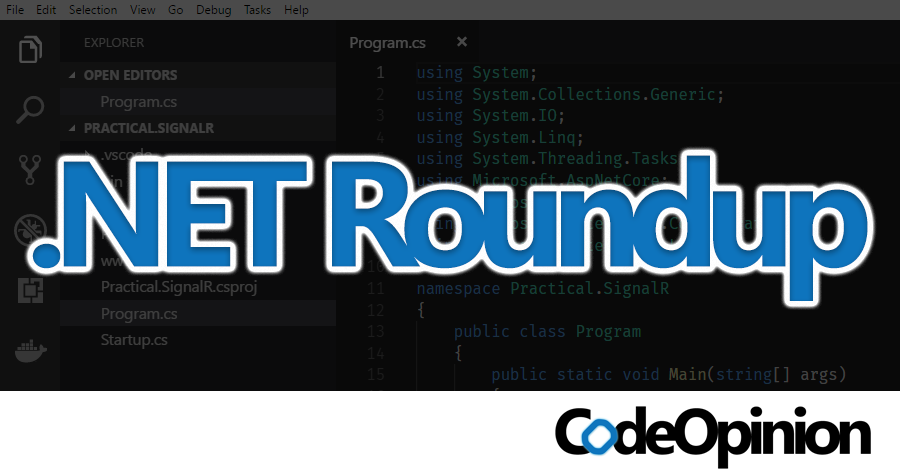Sponsor: Using RabbitMQ or Azure Service Bus in your .NET systems? Well, you could just use their SDKs and roll your own serialization, routing, outbox, retries, and telemetry. I mean, seriously, how hard could it be?

Here are the things that caught my eye recently in .NET. I’d love to hear what you found most interesting this week. Let me know in the comments or on Twitter.
ConfigureAwait FAQ
.NET added
async/awaitto the languages and libraries over seven years ago. In that time, it’s caught on like wildfire, not only across the .NET ecosystem, but also being replicated in a myriad of other languages and frameworks. It’s also seen a ton of improvements in .NET, in terms of additional language constructs that utilize asynchrony, APIs offering async support, and fundamental improvements in the infrastructure that makesasync/awaittick (in particular performance and diagnostic-enabling improvements in .NET Core).However, one aspect of
async/awaitthat continues to draw questions isConfigureAwait. In this post, I hope to answer many of them. I intend for this post to be both readable from start to finish as well as being a list of Frequently Asked Questions (FAQ) that can be used as future reference.To really understand
ConfigureAwait, we need to start a bit earlier…
Link: https://devblogs.microsoft.com/dotnet/configureawait-faq/
An Introduction to System.Threading.Channels
“Producer/consumer” problems are everywhere, in all facets of our lives. A line cook at a fast food restaurant, slicing tomatoes that are handed off to another cook to assemble a burger, which is handed off to a register worker to fulfill your order, which you happily gobble down. Postal drivers delivering mail all along their routes, and you either seeing a truck arrive and going out to the mailbox to retrieve your deliveries or just checking later in the day when you get home from work. An airline employee offloading suitcases from a cargo hold of a jetliner, placing them onto a conveyer belt, where they’re shuttled down to another employee who transfers bags to a van and drives them to yet another conveyer that will take them to you. And a happy engaged couple preparing to send out invites to their wedding, with one partner addressing an envelope and handing it off to the other who stuffs and licks it.
Link; https://devblogs.microsoft.com/dotnet/an-introduction-to-system-threading-channels/
Welcoming Oren Novotny as the new Executive Director of .NET Foundation
I started as .NET Foundation Executive Director in February 2017, and a lot has happened over the past nearly three years. We’ve added dozens of high quality projects and added a lot of services to support them, like automated code signing and releases. We launched a worldwide Meetup program that includes over a quarter of a million members, and supported them with hundreds of local events in our .NET Conf Local series. We’ve also ushered in substantial changes, literally years in the making, to open up membership, run an election for the board’s first elected directors, introduce a corporate sponsorship program, and lay the groundwork for the .NET Foundation to grow into its next stage.
Event Driven Collaboration – Ian Cooper
When we move from a monolith to microservices we abandon integrating via a shared database, as each service must own its own data to allow them it to be autonomous. But now we have a new problem, our data is distributed. What happens if I need one service needs to talk to another about a shared concept such as a product, a hotel room, or an order? Does every service need to have a list of all our users? Who knows what users have permissions to the entities within the micro service? What happens if my REST endpoint needs to include data from a graph that includes other services to make it responsive? And I am not breaking the boundary of my service when all of this data leaves my service boundary in response to a request?
Naive request-based solutions result in chatty calls as each service engages with multiple other services to fulfil a request, or in large message payloads as services add all the data required to process a message to each message. Neither scale well.
In 2005, Pat Helland wrote a paper ‘Data on the Inside vs. Data on the Outside’ which answers the question by distinguishing between data a service owns and reference data that it can use. Martin Fowler named the resulting architectural style; Event Driven Collaboration. This style is significant because it shifts the pattern from request to receiver-driven flow control.
In this presentation we will explain how events help us integrate our service architectures. We’ll provide examples in C#, Python and Go as well as using RMQ and Kafka.
Link: https://www.youtube.com/watch?v=PreAnSofAsA
What You Need to Know About Open Source – Trust Me, I’m a Lawyer – Jeff Strauss
eff is a software developer, an entrepreneur, and an attorney. As a consultant at WWT Asynchrony Labs, with unique experiences that combine technology and law, he maintains a passion for solving problems with inspired solutions, improving life through technology. A dedicated member of the developer community, Jeff travels internationally to speak on both technical and business-oriented topics. He is a Microsoft MVP and enjoys serving on the board of directors for the Kansas City Developer Conference.